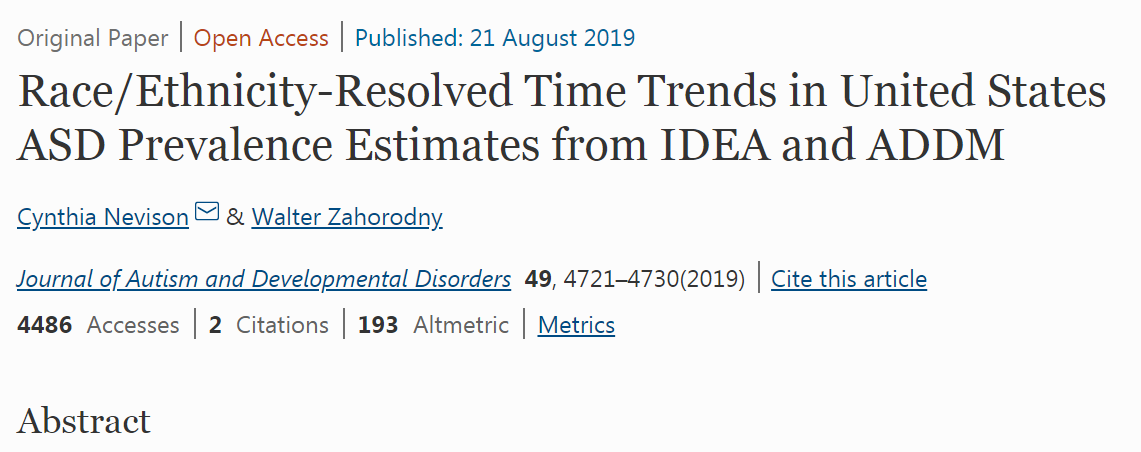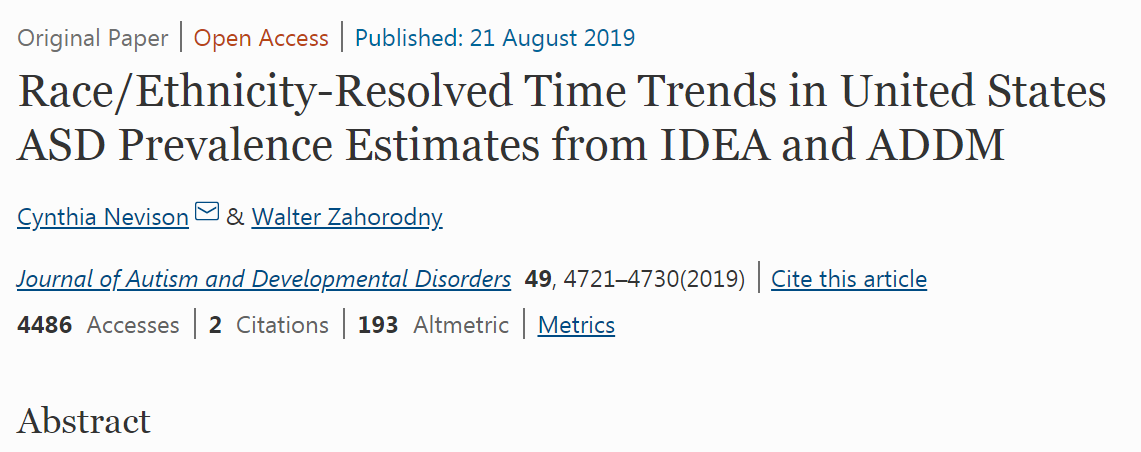1. Linking off a previous thread related to #healthinequities and #autism but this thread can stand alone. #epitwitter
This thread discusses recent studies that state the prevalence of autism in minorities is increasing beyond catching up to whites. https://twitter.com/ashtroid22/status/1264579580486189059?s=20">https://twitter.com/ashtroid2...
This thread discusses recent studies that state the prevalence of autism in minorities is increasing beyond catching up to whites. https://twitter.com/ashtroid22/status/1264579580486189059?s=20">https://twitter.com/ashtroid2...
2. I stumbled upon the article "Race/Ethnicity-Resolved Time Trends in United States ASD Prevalence Estimates from IDEA and ADDM", which I am posting as a screenshot to avoid boosting altmetrics. Which states that minorities prevalence of autism is increasing.
3. Given the known inequities in autism, a lot of effort has gone into promoting services and trying to reach vulnerable populations so that we can miss fewer applicable diagnoses. Given we miss minorities, we would expect that prevalence in minorities should be increasing.
4. This is because minorities previously weren& #39;t being diagnosed or were receiving the wrong diagnosis. Simply put, many say the prevalence of autism in minorities is finally catching up to whites. Lets first briefly discuss the increase in autism overall.
5. I don& #39;t like to use the terminology that autism prevalence is increasing because we actually don& #39;t know that. Identification is increasing. With this in mind it is unsurprising that the relative increase in whites is appearing to slow based on estimates.
6. But this paper says that they used some fancy analysis to determine if minorities are increasing beyond catch up and conclude that there is some environmental component responsible for that. I& #39;m being vague here because there was a lot of ambiguity.
7. So I read the paper, and i& #39;ll be honest at first pass there were a lot of immediate distractions-things I needed to see in the discussion drawn out. It seemed like social inequities played a large role in the results but were not acknowledged.
8. In fact, without considering social factors the methods appeared flawed to me. It just seemed weird. But if anyone has thoughts on the methods I am happy to hear them. Some really weird use of denominators without careful thought of what they meant.
9. In the discussion, there were points raised I had been waiting for but the authors would take them in the completed opposite direction. It felt unsettling to me, but let me highlight a few major points that didn& #39;t make the cut.
10. Some of the areas they stated had the highest overall increases in prevalence in minorities were noted to be areas that had higher populations of minorities. Including areas where the minority population surpassed the white population. These are areas that likely
11. had community efforts to expand services, making it more likely for minorities to receive a diagnosis, and may be less likely to fear of the structural issues given the outreach. I am not speculating on the increased services access- the authors state it. But what they dont
12. state is how this would influence the prevalence. These areas are inherently different. But then they use these prevalences in aggregate to argue that the prevalences are increasing beyond catch up. In fact their conclusions are based on the aggregate of prevalences.
13. Instead of looking at the prevalence across the country based on actual numbers, they pool prevalence in states. Making statements like:
"Hispanic prevalence estimates increased in 6/9 states and remained flat or decreased in Arizona, Arkansas and Missouri."
"Hispanic prevalence estimates increased in 6/9 states and remained flat or decreased in Arizona, Arkansas and Missouri."
14. "Black ASD prevalence increased in six states, but remained relatively flat or decreased in Arkansas, Maryland and North Carolina."
But they don& #39;t present the overall number of states per each group OR the raw count of prevalence across the US.
But they don& #39;t present the overall number of states per each group OR the raw count of prevalence across the US.
15. Wouldn& #39;t it be more useful to say in X # of states Black exceeded white prevalence? Either way you write this up the white total is still higher. It would also be nice to see what the total prevalence is by race for the overall country for the ADDM data source.
16. The data felt cherry-picked based on their use of two data sources but only picking the one that supports what they were saying-which happens to not be the official one used for estimates. The IDEAA data uses 3 and 5 year olds and ADDM (official) uses 8 yr olds.
17. Their source uses younger children which means only the most severe minorities were captured, those who received a late diagnosis are completely missed. And at 3 and 5, minorities are very likely to missed.
18. Whites continue to receive diagnoses as a result of less stigma and more resources and are less likely to have issues with this age capture. So are minorities really surpassing whites? I didn& #39;t find that conclusion.
19. Further, I have read A LOT of papers on autism and over time you are familiar with the same names. I have never seen this name before ) so I googled it and it seems Cynthia Nevison is a climate scientist? Here& #39;s a real plot twist. See next thread.

 Read on Twitter
Read on Twitter



